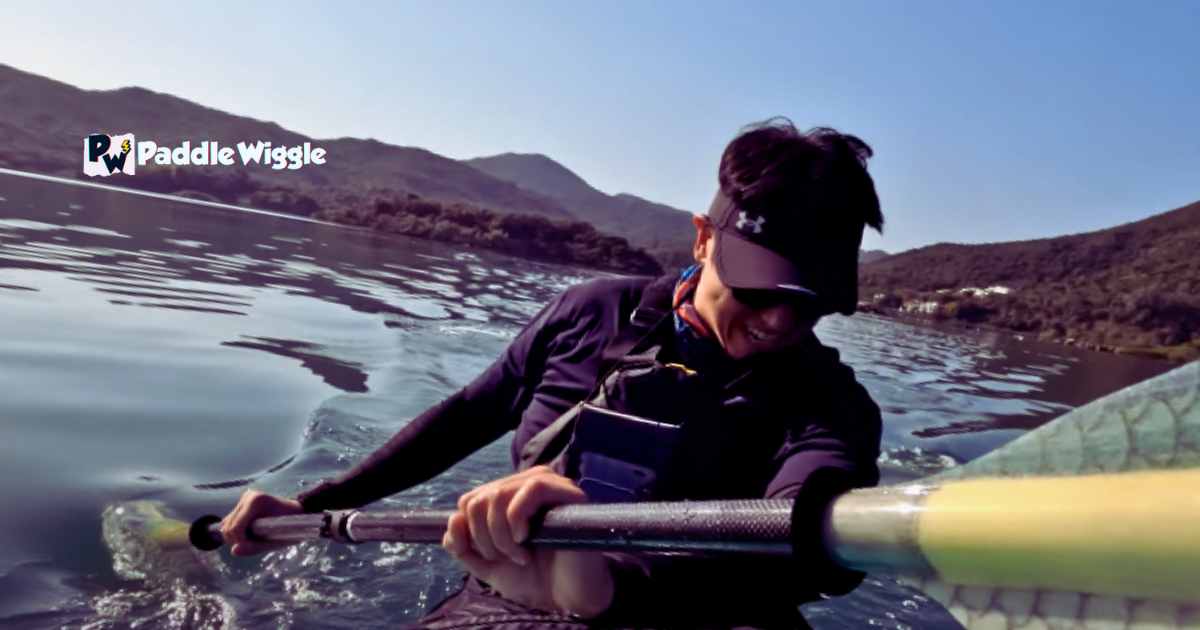Kayaking is more than just a fun water activity; it’s a way to boost your health. Unlike other water sports, like canoeing or boat tours, kayaking lets you explore nature at your own pace while improving your physical and mental well-being.
When you paddle a kayak, you’re getting a great workout. The rhythmic motion strengthens your muscles, builds endurance, and is easy on your joints. Plus, it’s an excellent way to improve your heart health because it requires stamina and coordination.
In this guide, we’ll explore the 11 key health benefits of kayaking, showing you why it’s not just an exciting adventure but also a path to a healthier and happier life. Whether you’re an experienced kayaker or considering trying it out, these benefits will inspire you to embrace the world of kayaking with enthusiasm. Let’s dive in!
Contents


The 11 Physical And Health Benefits Of Kayaking
From enhancing your cardiovascular fitness and strengthening core muscles to boosting mental health and reducing stress, kayaking offers a well-rounded approach to holistic well-being. Regular kayaking offers a range of physical and health benefits that can improve your overall well-being.
Let’s dive into the top 11 advantages of this thrilling water sport.
#1. Cardiovascular Fitness: Paddle Your Way To Heart Health
Kayaking is not just a fun water sport; it also offers a range of health benefits, particularly. Engaging in regular kayaking sessions can give your heart a workout, improve circulation, and reduce the risk of heart disease and stroke.
When you paddle in the water, your heart beats faster, and this is like doing a good aerobic exercise that makes your blood flow faster. It makes your heart muscles stronger and helps your heart work better to pump blood all around your body.
One of the great things about kayaking is that it provides a low-impact workout. Kayaking is a great exercise that’s kind to your joints. It’s different from high-impact exercises like running or jumping, which can be tough on your joints. This makes kayaking a good choice for people with joint problems or those who want a gentler workout.
When you kayak regularly, you make your upper body, especially your arms and shoulders, stronger. Paddling in the waterworks these muscles, and with time, they get even stronger. Strong upper body muscles don’t just make you more fit, but they also help with everyday tasks like lifting things or doing chores at home.
Research studies have found that kayaking, which is an aerobic exercise, is excellent for your heart and overall health. One study showed that regular kayakers had better cardiovascular endurance and used oxygen more efficiently. Another study from Harvard Medical School said that paddling sports like kayaking can lower blood pressure and improve your heart’s health. So, kayaking is not only fun but also super good for your heart!
If you’re new to kayaking and want to incorporate it into your fitness routine, here are some tips:
- Start slow: Start with short kayak trips where you paddle at a steady speed. Then, slowly make your trips longer and paddle harder as you get more comfortable.
- Warm up properly: Before you start kayaking, take a few minutes to do some gentle stretching exercises. This will warm up your muscles and help you avoid getting hurt.
- Use proper technique: Learn the correct paddling technique to maximize your efficiency and prevent strain on your body.
#2. Calorie-Burning Adventures In Kayaking


If you’re looking for a fun and exciting way to shed some pounds, kayaking might just be the answer! This water sport lets you see amazing places, and kayaking also burns calories. It can help you keep your weight in check and might even help you lose some.
Kayaking is a total package. Kayaking works out your whole body when you paddle in the water. It’s a great exercise for burning calories. Depending on how hard you paddle and how long you go kayaking, you can burn a lot of calories.
One of the great things about kayaking is that it offers a low-impact workout. Unlike high-impact exercises like running or jumping, which can put stress on your joints and muscles, kayaking is gentle on your body. The smooth movements of paddling help reduce the risk of injury while still providing an effective workout.
Regular kayaking sessions can improve not only your endurance but also your strength. As you paddle against the resistance of the water, your muscles are engaged, leading to increased muscle tone and overall physical fitness. Plus, being out on the water adds an extra element of enjoyment to your workout routine!
To give you an idea of how many calories you can burn during different types of kayaking activities:
- Leisurely paddling at a moderate pace burns approximately 283 calories per hour.
- Touring or sea kayaking at a moderate pace burns around 396 calories per hour.
- Whitewater kayaking or racing at a vigorous pace can torch up to 595 calories per hour.
Keep in mind that these numbers are estimates and may vary depending on factors such as body weight, intensity level, and individual metabolism.
Kayaking by itself won’t make extra weight disappear like magic, but when you pair it with a healthy diet and other types of exercise, it can be a helpful part of a plan to manage your weight. If you go kayaking often, you can burn more calories than you eat and slowly reach your weight loss goals.
Many individuals have successfully used kayaking as part of their weight management journey.
#3. Empowering Your Upper Body: Building Strength With Kayaking


Kayaking isn’t just a fun water activity; it can also do wonders for your upper body strength. When you paddle through the water, you engage various muscle groups, including your arms, shoulders, and back. Let’s dive into how kayaking can empower your upper body and provide a fantastic workout to build strength.
Kayaking is like pumping iron for your arms and upper body. As you paddle against the resistance of the water, your muscles work hard to propel you forward. This constant pushing and pulling motion helps tone and strengthen your arms, giving them definition and increased endurance.
But it doesn’t stop there! The repetitive paddling action also engages your shoulders and back muscles. These muscle groups are really important because they help keep the kayak steady and make sure you paddle the right way. When you kayak often, you’ll get stronger in these muscles, and that will make it easier for you to do regular tasks without getting tired.
Proper paddling technique is crucial in maximizing muscle engagement during kayaking. To make the most of this activity’s benefits, focus on using your core muscles to rotate your torso as you paddle. This rotation not only enhances the power of each stroke but also activates more muscles in your upper body.
To complement kayaking and further enhance upper body strength, consider incorporating specific exercises or stretches into your routine:
- Push-ups: This classic exercise targets multiple upper body muscles such as the chest, triceps, and shoulders.
- Rows: With resistance bands or dumbbells, do rowing movements to work on your back muscles.
- Shoulder presses: Strengthen your shoulder muscles by lifting weights overhead or using resistance bands.
- Yoga: Doing yoga can help you get more flexible and make your muscles stronger at the same time.
Don’t just take my word for it; fitness experts and experienced kayakers swear by the benefits of kayaking for upper body strength. They emphasize the importance of proper technique and consistency in achieving optimal results.
Kayaking is not only about physical benefits; it also has positive effects on mental well-being.
#4. Strengthening The Core: Balancing Act In Kayaking
When you balance in a kayak, it helps make your core muscles strong, especially your abs and lower back. When you’re kayaking, your core muscles are always working to keep you steady. So, every time you paddle, you’re not only moving forward, but you’re also giving your abs and lower back a good workout.
A strong core contributes to better stability, posture, and reduced risk of back pain. By strengthening your core through kayaking, you’ll notice improvements in your overall balance and stability both on and off the water. Plus, having a strong core can help alleviate back pain caused by poor posture or weak muscles.
Kayaking is an excellent workout for building core strength. Kayaking is different from regular gym exercises because it makes many muscles work at the same time, not just one. When you paddle, your abs, obliques (side muscles), and lower back all work together to keep you steady and paddle correctly.
It also helps to strengthen the upper body, including the arms and legs. While paddling, you’re not just using your arms; you’re engaging your entire upper body. The repetitive movement of pulling the paddle through the water targets the muscles in your arms, shoulders, chest, and upper back.
Kayaking is awesome because it’s a gentle exercise that doesn’t hurt your joints. Unlike activities like running or jumping rope, which can be tough on your knees and ankles, kayaking is kind to your joints. It’s a great option if you have joint problems or injuries.
Regular kayaking can improve endurance and increase heart rate. Kayaking might look relaxing, but it’s not! It’s actually a good workout for your heart. When you paddle through the water, you use your arms and legs, and it makes your heart beat faster, like in aerobic exercises.
To improve core strength through kayaking, focus on maintaining proper form and technique. Engage your core muscles by sitting tall with a straight back and using your abs to rotate your torso as you paddle.
#5. Enhanced Endurance
Kayaking isn’t just about having fun on the water; it also offers some serious health benefits. One of these benefits is enhanced endurance. Endurance means how long you can keep doing physical stuff without getting really tired or worn out.
Endurance is important for being in good shape because it lets you do outdoor activities for a longer time without getting tired. Kayaking is like a workout for your heart and is good for your heart health. It’s a gentle exercise that’s easy on your joints, and it gives you lots of physical benefits.
When you paddle steadily while kayaking, you work out many upper body muscles – your arms, shoulders, back, and core. Repeating this motion makes these muscles stronger. If you kayak often, your stronger muscles will let you paddle for a longer time without feeling tired.
To challenge and improve your endurance through kayaking, there are several training techniques and strategies you can employ:
- Gradual Progression: Start with shorter kayaking trips. As you improve and can paddle for longer, then you can go on longer trips.
- Interval Training: paddle really hard for a little while, then relax or go slower. This helps you build strength for quick bursts of energy and for keeping up a steady pace over a longer time.
- Cross-Training: Do other stuff like biking or swimming along with your kayaking to help your workouts and use different muscles.
- Strength Training: Do exercises that work the same muscles you use for kayaking. These include push-ups, pull-ups, and core exercises.
- Proper Nutrition: Eating a balanced diet with carbohydrates for energy and protein for muscle repair will help you build up your endurance.
Many avid kayakers have experienced significant enhancements in their endurance levels by incorporating regular kayaking into their fitness routines:
- Sarah started with short kayaking trips and gradually increased her paddling time. Now, she effortlessly tackles full-day kayaking excursions.
#6. Fluid Motion: Impact On Joint Flexibility
Paddling promotes supple joints, reducing the risk of stiffness and enhancing flexibility. Flexibility plays a crucial role. It supports smooth movement and can lead to greater comfort in daily activities. That’s where kayaking comes in.
Kayaking isn’t only about moving on the water; it also makes your body more flexible. It works many muscles in your arms, legs, and core. When you paddle, you have to twist and reach, which makes your body move in different ways and helps your joints become more flexible.
Regular kayaking workouts enhance your ability to twist and move with ease. As you paddle, you engage your core muscles and rotate your torso to generate power for each stroke. This repetitive twisting motion helps increase the range of motion in your spine and hips.
To complement kayaking and further enhance flexibility, there are specific stretches and exercises that you can incorporate into your routine:
- Arm Circles: Stand with your feet shoulder-width apart and extend your arms straight out to the sides. Make small circles with your arms, gradually increasing their size.
- Leg Swings: Stand next to a wall or sturdy object for support. Swing one leg forward and backward while keeping it straight.
- Trunk Rotations: Sit on the ground with your legs extended in front of you. Twist from side to side by rotating your upper body while keeping your lower body stable.
Flexibility is essential for injury prevention as well as overall well-being. Kayaking isn’t only about moving on the water; it also makes your body more flexible. It works many muscles in your arms, legs, and core. When you paddle, you have to twist and reach, which makes your body move in different ways and helps your joints become more flexible.
It’s important to include stretching exercises in your fitness routine to keep your joints healthy. Stretching before and after kayaking can warm up your muscles, improve blood flow, make your body more flexible, and stop injuries from happening.
Many individuals have experienced increased joint flexibility and comfort through kayaking. For example, John, a regular kayaker, used to struggle with stiffness in his shoulders and hips.
#7. Uplift Your Mood: The Mental Benefits Of Kayaking


Kayaking in natural settings is an uplifting experience, reducing stress, alleviating anxiety, and boosting mood. It’s not just about the physical benefits; kayaking also has a positive impact on mental well-being. In fact, it is considered a good therapy for reducing stress and improving mental health.
Engaging in regular kayaking workouts can improve brain function and cognitive abilities. As you paddle through the water, your mind becomes focused on the rhythmic motion, allowing you to escape from everyday worries and find a sense of calmness. This immersion in nature has been shown to have numerous mental health benefits.
Being in nature can help reduce feelings of depression and anxiety. Nature’s sights and sounds calm our minds and help us relax. When kayaking, the gentle movement of the water can make us feel mindful and less stressed. One big reason kayaking is good for mental health is that it makes us feel like we’ve achieved something. When we tackle tough waters or explore new routes, we gain confidence and feel better about ourselves. This boost in self-esteem carries over into other parts of our lives, making everything better.
People who’ve felt happier and less stressed because of kayaking share their stories. They say being on the water lets them take a break from everyday worries and reconnect with themselves. Kayaking helps them escape from technology and social media, providing peace and quiet that’s hard to find in today’s fast-paced world.
To maximize the mental benefits of kayaking, here are some practical tips:
- Choose serene locations: Find peaceful rivers or lakes that are in natural settings, so you can fully enjoy the experience.
- Practice mindfulness: Be aware of what’s around you, listen to the natural sounds, and feel the movements as you paddle. Allow yourself to be fully present in the moment.
#8. Sharpening The Mind: Kayaking’s Focus-Enhancing Effects
Kayaking isn’t just about being strong and having stamina; it also needs you to be mentally sharp and focused. When you’re on the water, your mind has to be completely in the moment, concentrating on steering through the water and avoiding obstacles. This strong focus is good for your thinking skills and your overall mental well-being.
Kayaking improves concentration and focus by requiring technique and precision. While you’re kayaking, you need to keep a steady speed, change how you paddle when things change, and find your way around anything in the water. This constant need for adaptability keeps your mind sharp and alert.
Kayaking can be soothing and help you relax. It’s like a calming, repetitive exercise that can make you forget about your worries. Paddling can feel like a kind of meditation, clearing your mind and making you think more clearly. It’s like hitting a reset button for your brain.
When you’re out on the water in a kayak, you become acutely aware of your surroundings. You need to pay attention to changes in wind direction, water currents, and potential hazards. This heightened awareness enhances situational awareness not only during kayaking but also in other aspects of life.
To enhance concentration during kayaking, try incorporating mindfulness exercises into your paddling routine. Before setting off on your adventure, take a few moments to center yourself and focus on your breath. As you paddle, pay attention to the sensations in your body—the movement of muscles, the sound of water splashing against the hull—and let go of any distracting thoughts.
Here are some strategies to help improve concentration while kayaking:
- Practice deep breathing: Take slow, deep breaths as you paddle, inhaling deeply through your nose and exhaling slowly through pursed lips.
- Engage all senses: Notice the sights, sounds, and smells around you. Feel the water against your paddle and the vibrations of the kayak.
- Stay present: Avoid getting lost in thoughts about past or future events. Keep your focus on the present moment and the task at hand.
#9. Joint-Friendly Exercise
Kayaking is a fantastic way to stay active and improve your overall health. One of the major benefits of kayaking is that it is a joint-friendly exercise, meaning it minimizes stress on your body while providing numerous physical benefits.
Kayaking is a type of exercise that makes your joints work relatively easily, unlike running or jumping, which can be tough on them. This means anyone, even people with joint issues like arthritis, can do it because it’s not too tough on your body. If you want an exercise that’s easy on your joints, kayaking is a great option for you.
When you paddle through the water in a kayak, you engage various muscle groups throughout your body. Your legs work to stabilize and propel the kayak forward while your arms and lats power each stroke. This full-body workout helps to strengthen and tone your muscles without placing undue stress on your joints.
In addition to building strength, regular kayaking sessions can also improve endurance and overall fitness levels. By paddling at a steady pace over an extended period of time, you’ll boost your cardiovascular health and increase stamina. It’s like getting a good aerobic workout while enjoying the great outdoors!
For individuals with joint issues, kayaking can be therapeutic in promoting joint movement and flexibility. The rhythmic motion of paddling can help lubricate the joints and reduce stiffness. Many doctors suggest gentle activities like kayaking to help people heal from joint injuries or surgeries. You don’t have to trust us; many people have shared their stories about how kayaking helped their joints. They felt less joint pain, moved better, and felt healthier by adding this fun sport to their routine.
If you’re thinking about trying kayaking for your joints, here are some things to remember. First, pick a kayak and gear that makes you feel comfy and safe. Look for kayaks with seats and footrests you can adjust to support your body well.
#10. Kayaking’s Revitalizing Impact On Lungs [Respiratory Health]
Kayaking is super healthy, especially for your breathing. When you go kayaking, it’s like giving your lungs a refreshing boost, which is great for your overall health. One big plus is that kayaking makes your lungs work better. When you paddle in the water, your heart beats faster, giving your heart and lungs a good workout. This makes you breathe deeply and control your breath, which is excellent for your lungs. If you kayak regularly, your lungs can get much better at taking in oxygen with each breath. This is super helpful for people with breathing problems like asthma or COPD.
Kayaking also makes your chest muscles, which help you breathe, stronger. Paddling works these muscles and helps them get tougher over time. Strong chest muscles mean your lungs can work well, and it helps you keep a good posture while kayaking. Kayaking is also good for your heart.
Paddling makes your heart work harder to pump blood all over your body. This helps make your heart and overall fitness better without being hard on your body. To get all the good breathing benefits from kayaking, focus on breathing deeply and regularly while on the water. Pay attention to your breath as you paddle; breathe in through your nose and breathe out through your mouth. This kind of breathing makes sure your lungs get all the fresh air they need.
Experts say that kayaking’s breathing benefits can make you feel better overall. It can boost your energy, reduce stress, and help you think more clearly.
#11. Camaraderie Afloat: The Social Joy Of Kayaking
Kayaking is not just about the exercise and excitement; it’s also a fantastic way to make friends. When people kayak together, it brings them closer, and you don’t feel alone.
Joining kayak tours or group activities is a great chance to hang out with friends and people who enjoy the same things. Whether you’re paddling on a river or a calm lake, kayaking lets you connect with others while enjoying nature’s beauty.
Being part of group kayaking activities is about more than just meeting new people. It’s a chance to make meaningful friendships. You might share stories, have fun, and face challenges as a team on the water. These experiences can create strong bonds that go beyond kayaking trips.
The social benefits of kayaking go beyond simple companionship. They have a positive impact on mental health and overall well-being. When we spend time with friends and talk to them, our brains make special chemicals, like oxytocin. These chemicals help us feel happy and not so stressed.
Here are some key aspects highlighting the social benefits of kayaking:
Bonding With Friends
- Kayaking with friends strengthens existing relationships by creating shared memories.
- It provides an opportunity to enjoy each other’s company while engaging in a fun outdoor activity.
- Sharing moments on the water can deepen friendships and create lifelong bonds.
Meeting Like-Minded Enthusiasts
- Taking part in kayak tours or group activities is a way for people who love adventure and nature to meet others who have the same interests.
- When you meet people who enjoy the same things as you, it helps you make new friends who truly get your passion for kayaking.
- These connections often extend beyond the water, leading to new friendships that enrich your life.
Emotional Support
- The camaraderie experienced during kayaking can provide emotional support, especially during challenging times.
- When you’re part of a supportive kayaking community, you have a network of people who understand and empathize with your struggles.
Boosting Endurance And Cardiovascular Health With Kayaking
Kayaking isn’t just about gliding through the water and enjoying the scenery. It’s also a fantastic way to improve your endurance and cardiovascular health. Let’s dive into how this thrilling water sport can give your heart a workout and boost your overall fitness.
Kayakers Develop Better Endurance Over Time
One of the key benefits of kayaking is that it helps you build endurance gradually. When you spend more time on the water and paddle more, it starts to feel easy and natural. This means you can go longer distances without getting tired. Kayaking, which is the exercise of paddling, makes your muscles stronger and gives you more endurance as you keep doing it.
Paddling Engages Major Muscle Groups Simultaneously
When you paddle a kayak, you engage multiple major muscle groups in your body simultaneously. Your arms, shoulders, back, and core all work together to propel the kayak forward. This full-body workout not only improves strength but also enhances coordination and balance.
Regular Participation Increases Lung Capacity
Kayaking involves sustained aerobic exercise, which means it gets your heart pumping while increasing oxygen intake. This continuous activity improves lung capacity as you breathe deeply during each stroke. Over time, increased lung capacity allows for better oxygenation of the blood and improved overall respiratory function.
The Combination Of Cardio Workout And Fresh Air Supports A Healthy Heart
It’s really important to do cardio exercises often to keep your heart healthy. Kayaking is a great way to do this while also having fun outdoors near lakes or rivers. When you paddle in a smooth, even way, it makes your heart stronger and helps your blood flow better in your body.
A Low-Impact Exercise Option
Kayaking is a gentle exercise done on water. It’s kind to your joints because it doesn’t involve hard impacts like running or jumping. This is great for people with joint problems or those getting better from injuries. When you kayak, you can get a good workout without hurting your joints too much.
Final Words
To sum it up, kayaking isn’t just a fun water activity; it’s a way to make your life healthier and more enjoyable. Besides the excitement of paddling in beautiful places, kayaking has many physical and health benefits.
It helps you get stronger, improve your heart health, reduce stress, and boost your mental well-being. It’s a way to connect with nature and feel better in body and mind.
So, whether you’re already a kayaking pro or thinking about giving it a try, remember that kayaking can make you a healthier, happier, and more vibrant person. Each time you paddle, you’re taking a step toward a better you.



